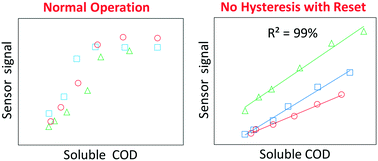Accurate and rapid organic detection by eliminating hysteresis in bioanode sensor applications†
Abstract
Bioanode sensors utilizing exoelectrogenic bacteria can be used for real-time and in situ assessment of water quality. The main challenges for practical applications of bioanode sensors in water quality assessment include their narrow detection range, long analysis time, and hysteresis effects. To overcome these limitations, a new operation method was proposed and examined in microbial electrolysis cell (MEC)-based bioanode sensors. The new operation method consists of normal operation (0.6 V application), a reset step (1.8 V application for 1 min), and a test step (1.2 V application for 2 min). The inclusion of the reset step in the sensor operation eliminated potential hysteresis effects and thus resulted in accurate correlations between readily biodegradable COD (chemical oxygen demand) and electric current with consistent R2 values of 99% in triplicated sensor experiments. The high voltage application (1.2 V) during the test step not only enhanced sensor accuracy but also extended the detection range up to 130 mg-COD L−1. The combination of a reset step and a test step was proven to allow reliable sensor applications of MECs and other bioelectrochemical systems. Even with the greatly improved sensor accuracy, the correlation between readily biodegradable COD (acetate) and electric current varied substantially in 2 days. The findings indicate that bioanode sensors can be used for rapid organic detection in 3 min with very high accuracies but require frequent sensor calibration.

- This article is part of the themed collection: CSC100: Celebrating Canadian Chemistry


 Please wait while we load your content...
Please wait while we load your content...